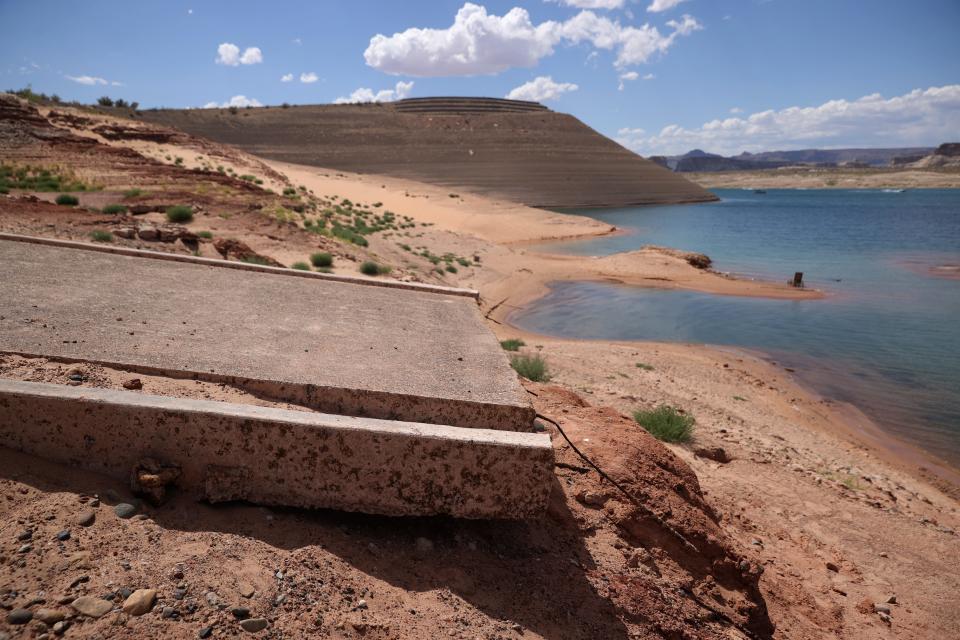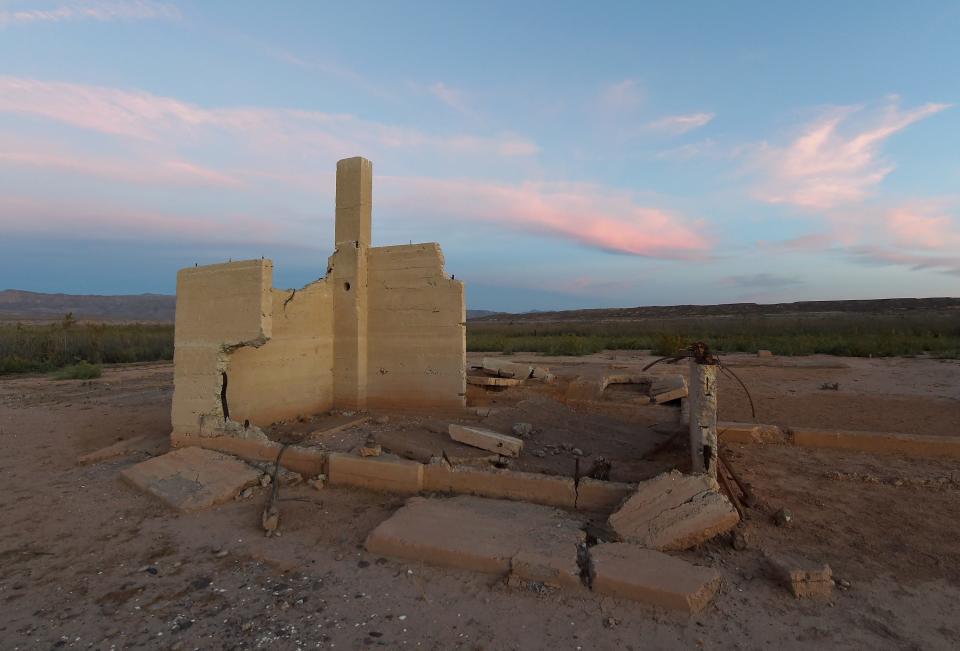A body in a barrel, ghost towns, a crashed B-29: What other secrets are buried in Lake Mead?
A body in a barrel. Human bones along the shoreline. Ghost towns. A crashed B-29 Superfortress used to track cosmic rays. Prehistoric salt mines. What will the rapidly receding waters of Lake Mead reveal next?
"This is just the tip of the iceberg," said Travis Heggie, a former National Park Service official who has studied deaths at Lake Mead Recreation Area. "I'm expecting all sorts of criminal things to show up, and I mean a lot."
The ongoing Western drought and heavy water use by surrounding states is draining Lake Mead, which sits between Nevada and Arizona, and the fast-dropping water level is exposing areas that have been covered up since the lake was first filled in the late 1930s. The reservoir today is about 30% full.
This month, boaters discovered a body stuffed inside a barrel in the area of the Hemenway Harbor boat ramp along the southwestern shoreline close to Las Vegas, police said. Investigators said the person inside the barrel appeared to have been shot, possibly sometime in the mid-1970s to early 1980s, based on clothes and footwear. At that time, Lake Mead was almost completely full and the water in the area would have been at least 20 to 30 feet deeper.
Another body was discovered by paddleboarders a week later on May 7 in the Callville Bay area, northeast of where the first was found. Both deaths are being investigated by the Clark County Medical Examiner's office, which declined to comment.
LAKE MEAD: Water so low in massive reservoir that an intake valve is now exposed
Experts like Heggie say Lake Mead's proximity to Las Vegas — 20 miles from the Strip, as the crow flies — make it highly likely more finds should be expected, especially given the reputation of Sin City as a home for the mob. Among the items they expect to find will be sunken boats, stolen cars and discarded firearms.
Lake Mead is the nation's largest built reservoir, created by blocking the Colorado River with the Hoover Dan, and it began filling in 1934. And although it has been completely full several times, the lake has been receding for years and is now about 176 feet below its full capacity.
Water levels have dropped so much in recent years that the Southern Nevada Water Authority had to build $522 million pumping station that was turned on last week because the original intake valve is now sticking out of the water, instead of being about 150 feet below the surface.
Large portions of the country west of the Rockies are in drought, and authorities in California, Arizona and other states have been implementing restrictions to help stretch the supply. Experts have warned the droughts are intensifying as a result of climate change.
IN THE WEST: The intense dry spell in the West is worst 'megadrought' in 1,200 years
'Constantly discovering new things'
While the bodies have given new attention to Lake Mead's shrinking shoreline, historian Mark Hall-Patton says the lake contains far more, including a surplus WWII B-29 converted to measure cosmic rays that crashed in 1948, and a handful of towns abandoned as the waters rose.
A small number of scuba divers are permitted to dive on the plane crash site each year. The plane used to be about 280 feet below the surface but is now only about 100 feet deep.
"You've got this huge body of water and it covered everything up," said Hall-Patton, a retired Clark County Museum administrator who has lived in the Vegas area for nearly 30 years. "You don't want something found, you just dump it in the middle of the lake. It's an easy place to dump things."
Still, Hall-Patton said, it's highly unlikely there are large number of mob bodies beneath the lake: "It would be an easy place to dump something, but they weren't killing people all the time."
Heggie, the former National Park Service official, said he suspects many of the bodies found in the lake would be boaters and swimmers who drowned or died from carbon monoxide poisoning. But he remains convinced crime victims could be among the dead.
"I have been curious for 20 years what all we're going to find at the bottom of these lakes," he said. "It's just so close to Vegas, and that wasn't known for being a safe town."
DEEP-SEA SECRETS AND THE 'SHIP OF GOLD': While a treasure hunter sits behind bars, his bounty tours the nation.
Melissa Chiella, who has guided tourists around the Hoover Dam and Lake Mead, said the changing water levels have prompted her company, Bindlestiff Tours, to alter some of its routes. She said tourists are wowed by the now-uncovered ghost towns and Native American ruins.
"Our guides are constantly discovering new things," said Chiella, the company's operation's manager. "We're seeing things that have never been exposed before."
Chiella said the company's guides — who also lead tours across the West and in Alaska — use the dropping water levels as a way to explain climate change to customers, many of whom have only an abstract concept of what it means.
In addition to Lake Mead, the upstream reservoir Lake Powell, which also dams the Colorado River, has dropped to historically low levels due to the drought exacerbated by climate change.
"We're using it as a platform to talk about climate change, and it has really allowed us to guide on a more connected level," Chiella said.

Ghost towns and the Lost City
Among the ghost towns now poking out of the water is St. Thomas, settled by Mormons, and once an important stopover on the pioneer route from Salt Lake City to Los Angles. When the lake was full, the surface was 60 feet above the top of the flooded town's tallest buildings, but now the entire settlement has been re-exposed.

Still hidden beneath the water is the Pueblo Grande de Nevada, also known as the Lost City, and once home to proto-Puebloan people who abandoned the site hundreds of years before white settlers moved into the area.
There are also caves where Native Americans harvested salt to preserve food.
Archeologists and anthropologists hurriedly excavated and examined some of those sites as Lake Mead began filling in the 1930s, according to the National Park Service said.
"But for every discovery saved, myriad others were lost," the National Park Service says. "All future study of the area would be limited to the hastily assembled collections and notes of the pre-Lake Mead archaeologists. By the 1950s it was already obvious to historians, archaeologists and anthropologists that the surviving artifacts of Lost City raised more questions than answers. Answers that would remain lost at the bottom of Lake Mead."
This article originally appeared on USA TODAY: Lake Mead bodies found as water level drops: What else is hidden?

